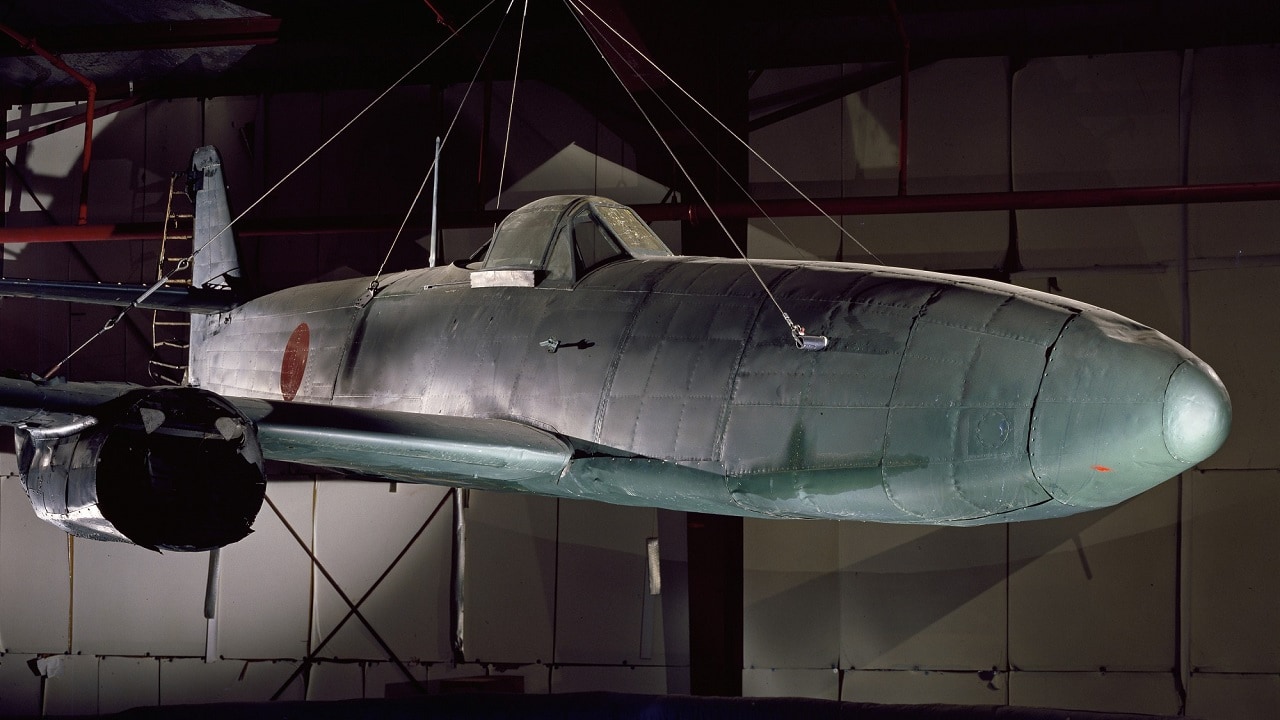As I mentioned in my article on the Bell P-59 Airacomet, the United States boasted many great accomplishments in the Jet Age, but lagged behind Nazi Germany’s Messerschmitt Me 262 Schwalbe (Sparrow) and Great Britain’s Gloster Meteor.
These jet fighters became operational during the Second World War, while American jet fighters would not see any combat until the Korean War.
Imperial Japan’s World War II-era efforts at jet combat, however, are often overlooked. Say hello to the Nakajima Kikka, Japan’s first jet aircraft.
Nakajima Kikka Early History and Specifications
The Nakajima Kikka (Orange Blossom) made her maiden flight on Aug. 7, 1945, with Lieutenant Commander Susumu Takaoka at the controls. This was a mere day after the Enola Gay dropped the first atomic bomb on Hiroshima.
The warbird was built by the Nakajima Aircraft Company, best known for constructing the B5N torpedo bomber used for the Pearl Harbor raid; the Ki-43 Hayabusa (Peregrine Falcon), a fighter plane often mistaken for the far more famous Mitsubishi A6M Zero; and the Ki-84 Hayate (Gale) fighter plane that was a key part of Japan’s last-ditch attempts to stop B-29 bombing raids.
Germany’s Me 262 inspired the Kikka. The Japanese air attaché to Nazi Germany witnessed a number of the Schwalbe’s flight trials and relayed enthusiastic reports back home. The naval staff then directed Nakajima in September 1944 to develop a twin-jet, single-seat attack aircraft.
Specifications included a range of 205 kilometers with a bomb load of 500 kilograms, or 278 km with a load of 250 kg. Max airspeed was a surprisingly modest 696 kilometers per hour, with a landing speed of 148 kph, and a takeoff run of 350 meters with rocket assist.
Fuselage length was 8.1 meters, wingspan was 10 meters, and height was 3 meters, with an empty weight of 2,300 kg and a gross weight of 4,080 kg.
What Went Wrong, i.e. Too Little, Too Late for WWII
As already mentioned, the A-bomb was dropped on Hiroshima the day before the Kikka’s first test flight.
Three days later, of course, Bockscar dropped the second A-bomb on Nagasaki. On Aug. 15, 1945, Japan surrendered, and the Kikka was officially retired on that same day.
The Kikka was also set back by a crash landing. Takaoka attempted a second flight four days after the maiden flight, but, as explained by Russell Lee, curator in the Aeronautics Department of the Smithsonian Institution’s National Air and Space Museum:
“[H]e aborted the takeoff and crashed into Tokyo Bay, tearing off the landing gear. Various sources offer different causes for the crash. One writes that technicians had mounted the two takeoff-assist rockets at the wrong angle on the fuselage while another ascribes blame on the pilot who mistook the burnout of the takeoff rockets for turbojet engine trouble, throttled back, and executed a safe but unnecessary crash landing… Another prototype was almost ready for flight and American forces discovered about 23 Kikka aircraft under construction at the Nakajima main factory building in Koizumi (present day Oizumi in Gunma Prefecture), and at a site on Kyushu Island.”
Where Are They Now?
There is a surviving Nakajima Kikka airframe on display at the Mary Baker Engen Restoration Hangar of the Smithsonian’s Udvar-Hazy Center in Chantilly, Virginia.
To quote Lee one more time, “U.S. Navy records show the Museum’s Kikka at NAS Patuxent River, MD on February 18, 1949. The aircraft was shipped from Norfolk on September 2, 1960 to the Paul Garber Facility in Suitland, MD. Museum staff accessioned the Kikka into the collection on March 13, 1961.”
MORE: World War III – Where Could It Start?
MORE: A U.S.-China War Over Taiwan Would Be Bloody
Christian D. Orr is a former U.S. Air Force Security Forces officer, Federal law enforcement officer, and private military contractor (with assignments worked in Iraq, the United Arab Emirates, Kosovo, Japan, Germany, and the Pentagon). Chris holds a B.A. in International Relations from the University of Southern California (USC) and an M.A. in Intelligence Studies (concentration in Terrorism Studies) from American Military University (AMU). He has also been published in The Daily Torch and The Journal of Intelligence and Cyber Security. Last but not least, he is a Companion of the Order of the Naval Order of the United States (NOUS).

